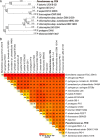Draft Genome Sequence of Pseudomonas sp. Strain FEN, Isolated from the Fe- and Organic Matter-Rich Schlöppnerbrunnen Fen
- PMID: 33446583
- PMCID: PMC7849696
- DOI: 10.1128/MRA.01017-20
Draft Genome Sequence of Pseudomonas sp. Strain FEN, Isolated from the Fe- and Organic Matter-Rich Schlöppnerbrunnen Fen
Abstract
Here, we report the draft genome sequence of Pseudomonas sp. strain FEN, a nonfluorescent siderophore producer that was isolated from the Schlöppnerbrunnen fen, which is characterized by high concentrations of Fe, dissolved organic matter (DOM), and Fe-DOM complexes. This draft genome sequence provides insight into the mechanisms of siderophore biosynthesis and siderophore-mediated iron uptake by this bacterium.
Copyright © 2021 Cooper et al.
Figures

References
LinkOut - more resources
Full Text Sources
Other Literature Sources
Molecular Biology Databases

